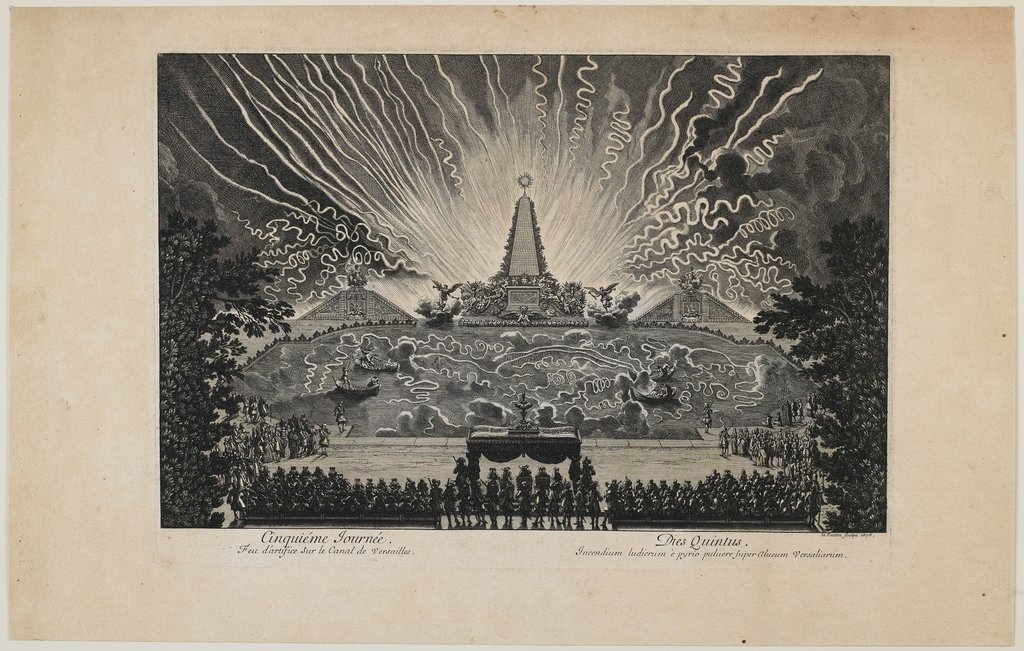By Anne Correll
Title: The Fête of 1674, Versailles: Fifth Day, August 18, Fireworks on the Grand Canal
Artist: Jean Le Pautre (Paris 1618-1682 Paris)
Published: From André Félibien, Les divertissements de Versailles donnez par le roy à toute sa cour au retour de la conquest de la Franche-Comté en l’année M.DC.LXXIV (Paris: Imprimerie royale)
Date: later reprint of the 1675-1676 plate
Medium: Etching and engraving
Dimensions: 11 ½ x 16 ½ in.
Source: Minneapolis Institute of Art
Ablaze with the brilliance of exploding pyrotechnics, Louis XIV’s mesmerized court beholds the spectacle alongside their king, who takes his rightful place in the center of the audience. Such was the wonder that Jean Le Pautre set out to capture in depicting this scene from the 1674 fête Les divertissements de Versailles. During the third decade of his reign, the French king held three festivals, each more lavish and spectacular than the last. This, the last, took place over six days in July and August and celebrated Louis XIV’s conquest of the Franche-Comté. The first fête, Les Plaisirs de l’Isle enchantée, was held in 1664 when Versailles had only just been transformed from a royal hunting lodge into a château. The second, the Relation de la feste de Versailles, took place over the course of one evening in July 1668.
The French Crown disseminated these events to a wider audience several years later with the publication of three festival books by the Imprimerie royale in 1673, 1676, and 1679, each with accompanying text by Louis XIV’s official court historian, André Félibien, and featuring prints by the most valued court engravers. These illustrated descriptions of the fêtes at Versailles, which were sold and given as gifts, participated in a wider genre of European festival books and put Louis XIV’s court in direct competition with other monarchies. French missionaries took the volumes as far as China, where they gifted them to the emperor and his court. These publications, both within France and in other countries, were incredibly successful and have been deemed the apex of French festival books.[1]
The festivals at Versailles, and their commemorative volumes, often celebrated the relationship between nature and art. The palace and gardens were outfitted with temporary structures, underscoring the transient magnificence of these events. The movement of the courtly body through these temporary spaces was emphasized and put on display as ballets were performed, labyrinths were navigated, and members of the court watched each other watching the spectacles. Following the first two festivals, permanent structures were built in the gardens to commemorate the temporary decorations. In this way, the third and final fête was the most “complete” because it displayed both the commemorative and temporary structures. The obelisk with the sun rising above it pictured here is one such example of this festival architecture. Situated on axis with the king, it is symbolic of his recent military victories.
Fireworks figured as prominent events in all three Versailles fêtes. Félibien described the display at the second festival of 1668 as a particularly exciting event because the fireworks were prepared so successfully in secret that courtiers were surprised and amazed when they began exploding in front of them. Le Pautre’s depiction of this scene is decidedly more chaotic than his fireworks scene of 1674 in that it depicts spooked horses and ominous clouds of smoke. This element of surprise, a major theme of the 1668 fête, was no longer a goal by the final fête. Instead, the transformation of the gardens with the newly erected structures was meant to instill a sense of awe that festival-goers could lose themselves in. Le Pautre shows them completely dazzled in a climatic moment that, inherently, cannot last for more than a few seconds but lives on through the artist’s skillful rendering of the fiery light against the dark night sky.
Through his skilled hand and imaginative compositions, Le Pautre ultimately became one of the court’s most successful print artists. Here he perfectly displays the simultaneous chaos and grandiosity of a fireworks show. Corkscrew explosions are lit against densely hatched lines, underscoring the drama of the rising sun above the obelisk. Le Pautre mirrors the serpentine fireworks and billowing clouds of smoke in the canal, where men in boats launch more rockets. Most famous for his work as a designer of decorative prints, his delicate rendering of detail in the structures around the garden offset the bold chiaroscuro. As was typical for the festival prints of Versailles, we see the scene from behind the audience of courtiers, so that we may observe them in their awe and, therefore, appreciate and participate in the courtly event as they would have.
[1] Peter Fuhring, Louis Marchesano, Remi Mathis, and Vanessa Selbach, A Kingdom of Images: French Prints in the Age of Louis XIV, 1660-1715 (Los Angeles: Getty Research Institute, 2015), 262-264.
